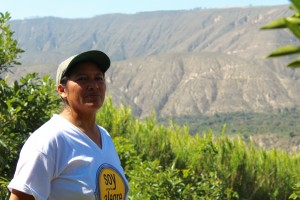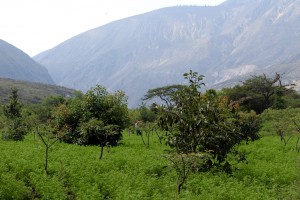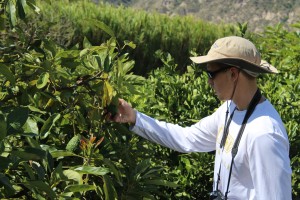Trip to Andean Dry Forest
A couple of weeks back, I took a class trip to an eco-farm called Hacienda Verde in the Andean dry forest, about 30 miles north of Quito. During our time there, I learned about some aspects of Ecuadorian rural culture and also how water is managed in Ecuador.
At the time, I was taking a class called Wildlife Conservation Management. The focus of the class was to investigate the goals and challenges of conserving wildlife, both plants and animals, in Ecuador. The eco-farm we visited turned out to be a perfect model of this kind of work. The mission of Hacienda Verde, taken from their website, is to create “a botanical garden of Andean fruits that will reflect the biodiversity of fruit species and varieties cultivated in Ecuadorian dry valleys.” Due to its geographical location on the equator, Ecuador’s climate is famous for producing a wide variety of fruits. Bananas alone make up 61% of Ecuador agricultural GDP in 2009 (Global Agricultural Information Network 2011)
However, due to this commercialization of agriculture, many farmers have stopped growing many other native species of fruit in favor of the single, nationally recognized fruits. For instance, we all know what an avocado looks/tastes like. But did you know that there are at least 11 other species of avocados native to Ecuador? This is what our guide at Hacienda Verde told us, and showed us different trees around the farm with different kinds of avocados. Others too have tried to record the different kinds of avocados. She told us we could pick some if we wanted; some of us stuffed our pockets as you can see from the picture below.
Most of these species perish quickly, and thus, have to be consumed locally instead of being shipped for export. And since there is not much profit to be made in these types of avocados, they are at risk of being lost from knowledge.
Hacienda Verde has a mission to bring these native fruits back into production by sustainably cultivating them on a small-scale. Through their work, they conserve many different types of native species. They also hire their laborers from the neighboring villages. One of the workers, María, accompanied us on our tour of the farm, showin g us different plants and explaining their uses.
g us different plants and explaining their uses.
As a rural community, the culture is still highly influences by animistic beliefs. At one point, María went to go pick a fruit from a tree. She explained to us that you have to ask the plan’s permission before you take its fruit. One of the students in our group asked if the plan every said “no”. She responded (in Spanish) “no, it depends on your hands; if you have good hands”. Later, we heard one of the workers singing in the grove to the trees. María told us that the plants love to hear music because it has good energy. By the end of the day, it was very evident that there existed a mutual respect between the workers and the land.
You may be wondering how there can be a farm in a “dry forest”. While the farm itself is not a dry forest, it is part of the Jerusalem Dry Forest system, one of the last remnants of Andean dry forests in Ecuador. This dry forests, sited at 8,000feets above sea level, receives 23 inches of water a year, and experiences an average annual temperature of 63 o. Of course, farming is naturally infeasible in these conditions. However, canals built on the slopes of the neighboring mountains bring water to the farm from the Andean highlands (which I will talk about in my next post). In the picture below, you can see the vegetation lines along the mountain where the canal runs.
When I asked how the farm acquired this water, our tour guide gave us a little insight into how water is managed Ecuador:
“We are permitted to use the water, but we need to show that we are putting the water to good use.”
I thought that this sounded a lot like prior-appropriation water rights in the US, where the stakeholder is able to use water as long as he is putting it to a “reasonable use”. And since they are at the terminal of the canal, so they are most effected by any changes in the flow of the canal. Furthermore, if the canal needs maintenance, it’s a community effort to go out and fix it.
Throughout the farm they have an irrigation system of channels and depending on where they need they water, they are able to divert the water.
Overall, I was most impressed by their great reverence toward the land and their good ecological work. Not only do they treat their farm with respect, they also are preserving the biodiversity of fruits in Ecuador against the threat of commercialization.


